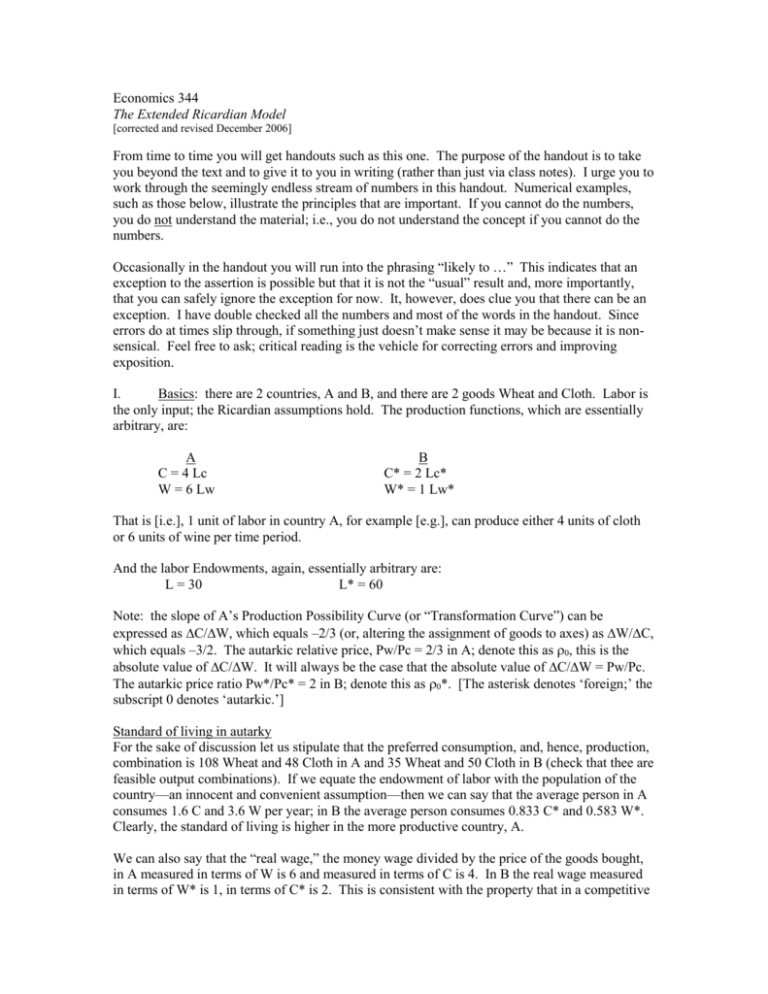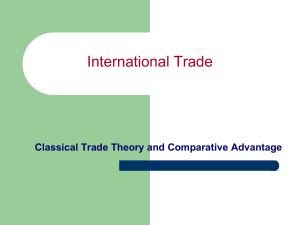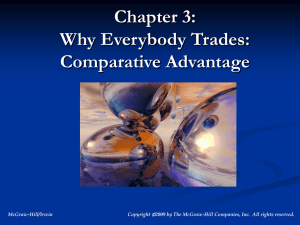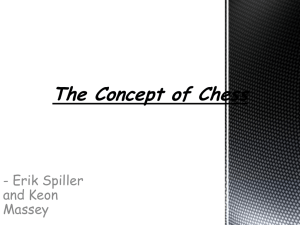Handout on Ricardian Model
advertisement

Economics 344 The Extended Ricardian Model [corrected and revised December 2006] From time to time you will get handouts such as this one. The purpose of the handout is to take you beyond the text and to give it to you in writing (rather than just via class notes). I urge you to work through the seemingly endless stream of numbers in this handout. Numerical examples, such as those below, illustrate the principles that are important. If you cannot do the numbers, you do not understand the material; i.e., you do not understand the concept if you cannot do the numbers. Occasionally in the handout you will run into the phrasing “likely to …” This indicates that an exception to the assertion is possible but that it is not the “usual” result and, more importantly, that you can safely ignore the exception for now. It, however, does clue you that there can be an exception. I have double checked all the numbers and most of the words in the handout. Since errors do at times slip through, if something just doesn’t make sense it may be because it is nonsensical. Feel free to ask; critical reading is the vehicle for correcting errors and improving exposition. I. Basics: there are 2 countries, A and B, and there are 2 goods Wheat and Cloth. Labor is the only input; the Ricardian assumptions hold. The production functions, which are essentially arbitrary, are: A C = 4 Lc W = 6 Lw B C* = 2 Lc* W* = 1 Lw* That is [i.e.], 1 unit of labor in country A, for example [e.g.], can produce either 4 units of cloth or 6 units of wine per time period. And the labor Endowments, again, essentially arbitrary are: L = 30 L* = 60 Note: the slope of A’s Production Possibility Curve (or “Transformation Curve”) can be expressed as C/W, which equals –2/3 (or, altering the assignment of goods to axes) as W/C, which equals –3/2. The autarkic relative price, Pw/Pc = 2/3 in A; denote this as 0, this is the absolute value of C/W. It will always be the case that the absolute value of C/W = Pw/Pc. The autarkic price ratio Pw*/Pc* = 2 in B; denote this as 0*. [The asterisk denotes ‘foreign;’ the subscript 0 denotes ‘autarkic.’] Standard of living in autarky For the sake of discussion let us stipulate that the preferred consumption, and, hence, production, combination is 108 Wheat and 48 Cloth in A and 35 Wheat and 50 Cloth in B (check that thee are feasible output combinations). If we equate the endowment of labor with the population of the country—an innocent and convenient assumption—then we can say that the average person in A consumes 1.6 C and 3.6 W per year; in B the average person consumes 0.833 C* and 0.583 W*. Clearly, the standard of living is higher in the more productive country, A. We can also say that the “real wage,” the money wage divided by the price of the goods bought, in A measured in terms of W is 6 and measured in terms of C is 4. In B the real wage measured in terms of W* is 1, in terms of C* is 2. This is consistent with the property that in a competitive 2 labor market labor is paid the value of its marginal product, which in, say, the Cloth industry is Pc MPLC = Pc C/LC = w. Hence, the real wage in terms of Cloth is w/PC = C/LC. reinforce this result, set up an example with money prices at some—any—level. Let Pw = $8, then the wage rate, w, must be $48 ($48 = $8 times 6). Then Pc must be $12. Note Pw/Pc is, indeed, 2/3. Also the real wage in terms of, say, Cloth is $48/$12 = 4. II. Now let trade open up. The situation where each country has its own set of prices is now no longer satisfactory. If the two countries’ markets are integrated through trade (and given our assumption of costless trade and homogeneous products) the prices of Wheat (W) in the two countries will converge, as will the two prices of Cloth (C). There are two issues here. One is the fact that each country likely has its own currency; we need to be able to express the prices in the different currencies in terms of each other—this is the role of the foreign exchange rate. This is an interesting topic that will get more attention below, but right now it is not an issue of serious concern. The second issue is the relative price. Note that the relative price is “money-free,” that is, the currency units cancel out when the ratio is taken: the relative price in A in autaky is 2/3 cloth per wheat. With trade a single relative price, Pw/Pc, will develop in the integrated international market (since in the absence of transport costs, tariffs, and the like the price of Wheat will be the same everywhere, as will the price of Cloth). This is the “terms of trade.” Strictly, the terms of trade is the price of exports over the price of imports—note: since A’s exports are B’s imports, A’s T/T is the inverse of B’s T/T*. From A’s perspective (A exports Wheat) the T/T are Pw/Pc. We will denote the T/T from A’s perspective, (Pw/Pc)1, as 1 [where the “1” indicates the “free trade” value]. Consider first the issue of the two currencies. Let country A use the “dollar,” denoted by “$.” Let country B use the “pound sterling,” denoted by “₤ .” These currencies may actually circulate and serve the “medium of exchange” or “transaction” function or they may serve solely as “units of account.” It is the unit of account function that we require. The level of autarkic prices in either country is essentially arbitrary and a function primarily of the history of the domestic monetary policies. For starters, suppose that the wage in A is $12 per unit of labor; suppose the wage in B is ₤ 2. Immediately, given the production functions above and our assumptions of perfect competition in all markets, homogeneous goods, mobility of labor across industries within each country, etc, we know that the autarkic price structures in the two countries are: Pw A $2.00 Pw* B ₤ 2.00 Pc $3.00 Pc* ₤ 1.00 w $12.00 w* ₤ 2.00 (if you do not see where these numbers come from, stop, think, and work it out!) First, let’s ask if there are limits on the possible exchange rates between the dollar and the pound given this underlying autarkic price structure. The answer is “Perhaps, it depends.” On the one hand any exchange rate might be set and temporarily maintained by government actions. On the other hand, if we are interested in exchange rates consistent with Balanced Trade, which must be among those exchange rates that are consistent with two-way trade, the answer is a definite “Yes.” We will label exchange rate(s) that lead to balanced trade as “equilibrium rates.” We will look at an out-of-equilibrium rate first just to motivate the need to discover the equilibrium range. 3 a. Disequilibrium exchange rates Suppose the foreign exchange rate—the price of pounds in terms of dollars—is e($/₤ ) = $4/₤ . Then the dollar prices of B’s goods in autarky (and the pound prices of A’s goods) are: Pw* = ($4/₤ ) ₤ 2.00 = $8.00 Pw = $2.00 / ($4/₤ ) = ₤ 0.50 Pc* = ($4/₤ ) ₤ 1.00 = $4.00 Pc = $3.00 / ($4/₤ ) = ₤ 0.75 At these prices no one would buy either good in B—A underprices B in both goods in terms of either currency. Here A would export both goods and import neither, B would import both and export neither: when you buy goods you generally do not calculate comparative advantages (you don’t, do you?), what you do is compare prices and buy from the lower price source. In this example A has a “trade surplus,” B has a “trade deficit,” we say that B’s currency is “overvalued,” that A’s currency is “undervalued.” Notice that the consumers in B may be paying for the goods they buy from A with interest bearing I.O.U.s—or, perhaps, with actual pounds sterling. In the real world, this is NOT a situation that can long persist for most countries, rather the exchange rate—or the level of domestic prices—must adjust. (The U.S. happens to be one of the exceptions to this rule because the dollar is both a “vehicle currency” for transactions between all sorts of countries and because the dollar is a “safe haven” store of value. Dollars, basically, are per se of value to people outside the U.S.). b. Equilibrium exchange rates An equilibrium exchange rate must be one such that each country has an export good (trade could not otherwise be balanced). Exports are used to pay for imports. Why else would anyone ship out the fruit of their hard labor to foreignors? We can get the limiting exchange rates by determining the exchange rate such that the price of Wheat from either countries is the same when expressed in terms of a common currency and then likewise for the price of Cloth. These exchange rates give us the knife-edge values where one or the other good is just competitive in both markets. For Wheat: Pw = $2.00 For Cloth: Pc = $3.00 Pw* = ₤ 2.00 Pc* = ₤ 1.00 therefore e1($/₤ ) = $1 / ₤ therefore e2($/₤ ) = $3 / ₤ . Note that if e = $1.00 Wheat sells for the same price in both countries but Cloth is now cheaper in B, and B will export C. That is, B will export the good in which it has a comparative advantage. If e = $3.00 Cloth sells for the same price in both countries but Wheat is now cheaper in A. A sells its Wheat into the higher priced market, and B-residents buy from the less expensive source. A exports W. Any exchange rate between e1 and e2 will result in the “right” country having its comparative advantage in the “right” good. Experiment with values both between the limiting rates and outside these rates. Note that equilibrium also could come about if the price level fell in B—and it might since B’s producers can find no customers and B’s workers, therefore, can find no employment. Or, equilibrium could come about if A’s price level rose, and it might since the demand for A’s goods and, therefore, the demand for A’s labor are both intense. For most economies, however, exchange rates are likely to be more easily adjusted than is the domestic overall price level. (Think about it!) 4 Now to the issue of the equilibrium terms of trade. Trade will lead to convergence of money prices (after conversion to a common currency) both for Wheat and for Cloth. As a result the relative prices in each country will converge. We have established that 1 must lie between 0 and 0*. In terms of the numerical example 1 must lie between 2/3 and 2. Given that the production functions and endowments fully determine the supply side of the economy, then given that supply situation, the particular 1 that results will depend on the strength of consumers’ preferences for Wheat vs. Cloth. Other things equal, the greater the preference for Wheat (and hence, the lesser the preference for Cloth), the greater the value for 1, i.e., the higher the relative price of Wheat. Let’s suppose the equilibrium terms of trade, 1 = Pw/Pc = Pw*/Pc*, is 1.10. Let’s first consider what happens in “real” terms, then we’ll plug money values in to see what the world looks like in terms of money prices. The Ricardian model tends to lead to full specialization. (This is a serious shortcoming of the Ricardian model.) Hence, in the with-trade case A produces only Wheat (W = 180), and B produces only Cloth (C* = 120). With 1 = 1.10, each unit of Wheat exported by A brings in 1.10. units of Cloth. a. Gains from Trade: Real Analysis Let us continue to use the assumed levels of production and consumption quantities from above, i.e., A produces 108 W and 48 C and that B produces 35 W* and 50 C*. Prior to trade world output was 143 Wheat and 98 Cloth. With complete specialization, world output has changed to 180 Wheat and 120 Cloth. The world has gained 37 Wheat and 22 Cloth. Clearly, the “world” is better off. However, a useful question now is, “Who gains what?” Consider this [somewhat arbitrary] example: let A export 60 W, leaving 120W for domestic consumption. The 60 W will buy 66 Cloth; A is better off by 12 units of Wheat as compared to autarky, and 18 units of Cloth better off. B, on the other hand, will now consume 60 W (imported from A) and 54 C (120 – 66) and will be 25 units of W and 4 units of C better off. Clearly these particular values depend not only on a terms of trade of 1.10 but also on the buyers and sellers in both A and B being satisfied with this particular volume of trade—that is, had A desired to export only 40 Wheat the particular solution would have been different. This is something we need to come back to. (On your own try other terms of trade, convince yourself that if 1 = 1.20, i.e., if it is closer to B’s autarkic price ratio, and further from A’s, that A’s gains will be greater and B’s less. In the above case, the real wage in A in terms of W remains at 6—in the “constant returns to scale with one input” case, trade does not alter the marginal productivity of labor which, in turn, equals the real wage in terms of the good that is produced. The link between Cloth and A-labor, however, has been broken: A no longer produces C. Rather, the real wage is 6W, but this is equal, via the terms of trade, to 6.6 C. The productivity of labor in A in terms of C has risen, via constant productivity in W coupled with an improved terms of trade of W for C, from 4 to 6.6! Convince yourself that labor’s real wage in B similarly has gained in terms of Wheat. b. Gains from Trade: Monetary Example [this section can be safely skipped] Whenever we do a monetary example the level of money prices, and, hence, all the specific values are up to a point arbitrary. They are not, however, merely any numbers that come to mind. 5 Once certain values have been decided upon, the rest follow precisely. With that in mind, let’s proceed. Let’s start with the autarkic money prices as follows: A Pw* = ₤ 1.00 Pw = $1.00 Pc = $1.50 w = $6.00 B 0 = 2/3 Pc* = ₤ 0.50 0* = 2 w* = ₤ 1.00 Suppose when trade opens up the convergence to 1 proceeds with the money price of the export good rising in each country and the money price of the good that is imported falling. Let’s also have 1 = 1.10. These conditions will be satisfied by the following (as well as by any number of other specific values) numbers: A Pw = $1.54 Pc = $1.40 B Pw* = 0.77 Pc* = 0.70 Note here e($/₤ ) = $2 / ₤ . The wage rate in A must be $9.24 (= 6 times 1.54) since A produces only W. The wage rate in B must be ₤ 1.40 since only C is produced in B and each unit of labor produces 2 C. In purchasing power terms, the real wage in A in terms of W is still 6. The real wage in terms of C, however, is (w / Pc) = $9.24 / $1.40 = 6.6. In autarchy it had been only 4.00! Any A-worker who consumes some C is clearly better off, and that odd A-worker who consumes only Wheat is no worse off by trade. The wage rate in B is ₤ 1.40. In terms of C the real wage is 2.00, what it had been in autarky. The real wage in terms of W, however, has risen to (1.40 / 0.77) = 1.82, certainly better than the 1.0 under autarky. The “monetary’ examples simply confirm what the “real” analysis has already told us. In the Ricardian case both nations gain precisely because everyone in each country gains (except for those poor souls who consume only the home-produced export good, and they are no worse off). c. Reconsideration of the Determinants of the Terms of Trade: The terms of trade determine the division of the gains of trade between the two countries. Obviously they can be an important determinant of the domestic standard of living. Also note that the greater the share of international trade in GDP the greater is the importance of a given change in the terms of trade. The terms of trade can change if either the underlying demand or supply conditions for the traded goods change. By “demand” we really mean those factors that underlie demand, namely, tastes or preferences. By “supply” we really mean the production functions (technology) and endowments that figure so prominently in the Ricardian, and all trade, models. We cannot say very much about tastes except that if the world preference for Wheat strengthens (relative to Cloth) the relative price of Wheat will rise and the terms of trade for the Wheat exporter will improve. Two ways in which preferences might change are (i) the existing population simply 6 alters its preferences, e.g., a warming of the climate or a sun-worship movement might lead to a reduced preference for Cloth; (ii) tastes can also be effectively changed if there is a increase in the number of people who have a particular skewed set of preferences. Say, the population in one of the countries increases (without altering the labor endowment, so the change is solely on the demand side) and the preferences of this population is skewed in favor of Wheat. Then the demand for Wheat will grow relative to that for Cloth and the relative price of Wheat will rise. On the supply side we can say a great deal about the terms of trade. For instance, let the endowment of labor in B increase by 10 per cent. B’s production possibility curve will shift out by 10 per cent (due to constant returns to scale in both goods) without changing its slope. Let the tastes of the population be such that for any given value of (Pw/Pc) B-people wish to consume Wheat and Cloth in the same proportion regardless of how far out the PPC lies. This suggests that B’s production of Cloth (its export good, in which it is fully specialized) will increase by 10 per cent and that its quantity demanded of each of Cloth and Wheat will increase by 10 per cent. Hence, B’s demand for Wheat on the world market rises by 10 per cent. B’s supply of Cloth on the world market also rises by 10 per cent: B will increase both its quantity supplied and its quantity demanded of Cloth by 10 per cent but it produces more Cloth than it consumes. Its excess of supply over demand rises by 10 per cent—but this excess supply is what it exports. On the world market the demand for Wheat rises and the supply of Cloth rises: the price of Wheat will rise relative to the price of Cloth and B, here the growing economy, suffers a deterioration in its terms of trade. An important corollary is that the “other” country which has experienced no growth gains from its partner’s growth via the terms of trade effect! A second sort of supply change can come about if there is an improvement in productivity. Productivity could change in both industries, in only the export industry, or in only the import competing industry. What if B workers become 10 per cent more productive in both industries? The effect on B’s PPC is identical to the case considered above and all subsequent effects are the same [except that here there is an increase in per capita income, in the case above there was no increase in per capita income in autarky: both output and labor rose by the same 10 %]. What if B workers become 10 per cent more productive only in Cloth, the export good? III. Some Krugmanesque Thoughts: Here we will address some of the points that Krugman makes in “What Do Undergraduates Need to know About Trade?.” [attached at the end of the handout; look it over] Krugman’s point 3 has to do with increases in productivity. We can use the above discussion as background to this analysis. 1. Across the board increase in productivity in A: If productivity in A rises across all industries by 10 per cent then A’s production functions change to: C = 4.4 Lc W = 6.6 Lw Convince yourself that in autarky real income, measured in terms of either C or W, rises by 10 per cent. An increase in productivity is beneficial to a non-trading country. What if A, however, is a trading country? The opportunity cost of producing Wheat or Cloth are unchanged: 3 Wheat still exchange in domestic production for 2 Cloth. A still has its comparative advantage in Wheat. The productivity increase gives A no new advantage over B. In fact, once we allow for the likely deterioration in A’s terms of trade, we can say that a 10 per cent increase in productivity will increase with-trade real income in A by less than 10 per cent. (A still is better off with trade than without.) If you are not convinced, work out a numerical example. 2. Across the board and equal increase in productivity in both countries: Let productivity rise 10 per cent in both industries in both countries. With trade everyone is better off by 10 per cent, A 7 continues to export Wheat, and B exports Cloth. The only issue is whether there is a terms of trade effect and this depends on the impact of higher income on the worldwide demand for Wheat versus the demand for Cloth 3. Increase in productivity in only one industry in only one country: The result here depends on the industry, the country, and the magnitude of the productivity change. An increase in the productivity of Cloth in A [the un-produced good] will have no effects in the Ricardian model (but will in more realistic models) unless the productivity increase is large enough to switch A’s comparative advantage out of W and into C. If so, then we have a largely new story (with A workers better off; I suspect B workers will also gain once terms of trade effects are considered— but I have not worked that through. You might give it a try with some numbers—the bare minimum increase in C productivity would have to change the production function to C = 12.1 Lc. (Do you see why?) If the increase is in A only and only in the Wheat (export) industry, then A workers with trade (and in the Ricardian model they likely are all in the W industry with trade) are better off. But, again, the terms of trade will likely turn against A, and the A workers will not get the full gain of the productivity increase in terms of the import good, C. The improvement in B’s T/T will make B workers better off. ₤ €








